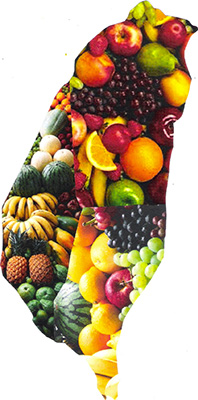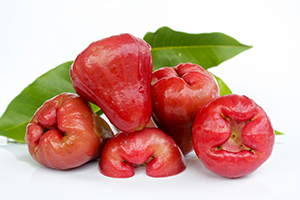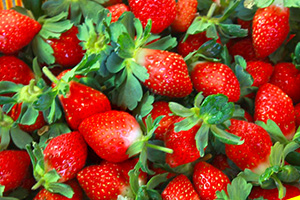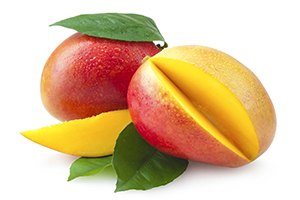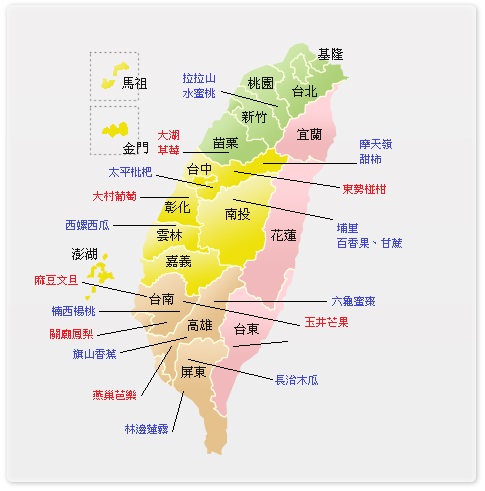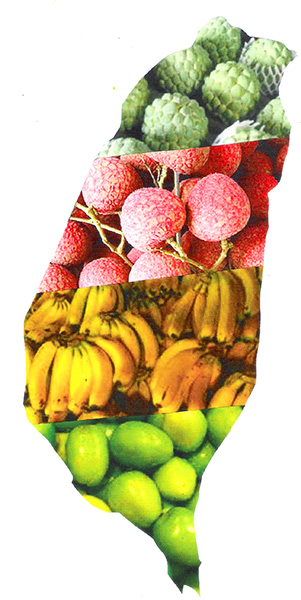 |
 |
 |
 |
 |
|||

1) The Land and Fruits
Taiwan is a narrow island with 394 kilometers in length and about 36,188 square kilometers large. With five types of landform, namely, mountainous areas, hills, plains, basins and plateaus, Taiwan is blessed with geographical varieties and advantages, and is comprised of tropical, subtropical and temperate climates at the same time. Thus Taiwan is the second hometown to many kinds of fruit and can see harvests all year round. Wax apple was originated in the Malayan Peninsula and was introduced to Taiwan from Java by the Hollanders. Its distribution in Taiwan ranges from Pingtung, Kaohsiung, Chiayi, Nantou, and Yilan, with Pingtung the largest town to grow this fruit. It is because the soil of coastal Pingtung is highly salty, which is most beneficial to cultivation of wax apples as it forces the fruits in the tress concentrated in nutrition and flavors. Hence the Black Pearl Wax Apple tastes exceptionally sweet. Three reasons account for the extraordinary sweetness of the wax apple grown in Pingtung are as follows: salty soil, clay soil, and most importantly, the weather. Wax apples, as a tropical fruit, are commonly grown in winter, at the range of temperature of 18 to 25°C. The Hungchun Peninsula is generally above 10°C all year round, which is optimal for bearing fruits and blossoming for wax apples. Wax apples at northern Taiwan are mostly grown in summer as they are likely to fall at northern parts of the island. Strawberries are grown in central and northern Taiwan, especially in Miaoli County. Some of the strawberry plantations are scattered round Guanxi (Hsinchu County), Guoshing (Nantou County), and Neihu (Taipei City). The plantations in Dahu, Miaoli account for 80% of the harvest in Taiwan. Since Dahu is itself a basin, of which the northern mountains prevent Northeast monsoon from north, and the weather in the basin is most appropriate for delicate strawberries that don’t like moisture. Dahu strawberries have a unique flavor because they are grown in the basin surrounded by mountains and hills. Aside from that, the temperature difference between day and night is drastic. Take winter for example. The temperature at day can amount to 28C, whereas it plummets to below 10C when night falls. The sunshine may increase sweetness and color of the strawberries, while low temperature may lessen the speed of growth, so the texture of Dahu strawberries are solider and crisper than strawberries grown elsewhere.
Aiwen Mango was first introduced to Yujing, Tainan from Florida, US in the 1950s. It was expanded to other districts in Tainan, Kaohsiung and Pingtung. Along the southeast side of Yujing, the hills are covered with clay and chalk soil, while the light-colored soil easily reflects the sunshine and proves to be good for mango growth. Such unfertile, moist-less land proves good to the plantation of mangos as the nutrition of the fertilizer can be concentrated on flowers and fruits. That accounts for the phenomenally sweet Aiwen mangos in Yujing. Aiwen Mango from Yujing beats all other varieties of mangos since Yujing is located at the suitable latitude, rightly below the Tropic of Cancer. When it blossoms in March, the temperature is between 20°C and 25°C. The warm climate renders an added month of growth for mango plantations in Yujing before it is gleaned. The extended growth time renders the taste of the mango rich and wonderful. Reference:
2) Seasons and Fruits Taiwan is divided into two kinds of climates as the Tropic of Cancer belts round Chiayi County. The northern part of Taiwan is subtropical monsoon climate while the southern part of it is tropical monsoon climate. Warm winter (especially in the plains and southern part of the island), hot summer (mostly above 20°C except for mountainous areas) and copious rain (especially in mountains, eastern coast and northern part) are three features of Taiwan’s weather. Plum rains can be found in May and June, and typhoons in June through September. There are sometimes cold waves in wintertime.
Note: The fruit followed with an asterisk is grown all year round. Reference:
3) Map of Fruits in Taiwan Many kinds of fruit are grown across Taiwan, yet certain districts might be most renowned for some kinds of fruit and has gradually been equivalent of the fruit itself. This shows the consumers’ appreciation of that district for growing best-tasting fruit in Taiwan.
By counties or cities Pingtung County / Papaya (Changjhih), Wax apple (Linbian)
Over the last years, Taiwan has seen a change of tides in fruit cultivation. Thus a new connection between the origin of fruit and fruit itself arises. For example, the fame of Nanhsi star fruit and Zhuolan star fruit have superseded Urlin star fruit, whereas Urlun watermelon has replaced Hsilo watermelon as the top watermelon in Taiwan. As to pomelos, Douliu and Madou are both famous origins, while Hekang (in Hualien) also grows juicy pomelos in recent years. Reference: http://www.applelife.com.tw/knowledge_show.php?id=113&pid=b&sid=5
By varieties of fruits
Star fruit / Changhua, Miaoli, Tainan, Yunlin, Pingtung Color palettes of fruit |
|||||||||||||||||||||||||||||||||||||||||||||||||||||||||||||||||||||||||||||||||||||||||||||||||||||||||||||||||||||||||||||||||||||||||||||||||||||||||||||||||||||||||||||||||||||||||||||||||||||||||||||||||||||||||||||||||||||||||||||||||||||||||||||||||||||||||||||||||||||||||||||||||||||||||||||||||||||||||||||||||||||||||||||||||||||||||||||||||||||||||||||||||||||||||||||||||||||||||||||||||||||||||||||
|
